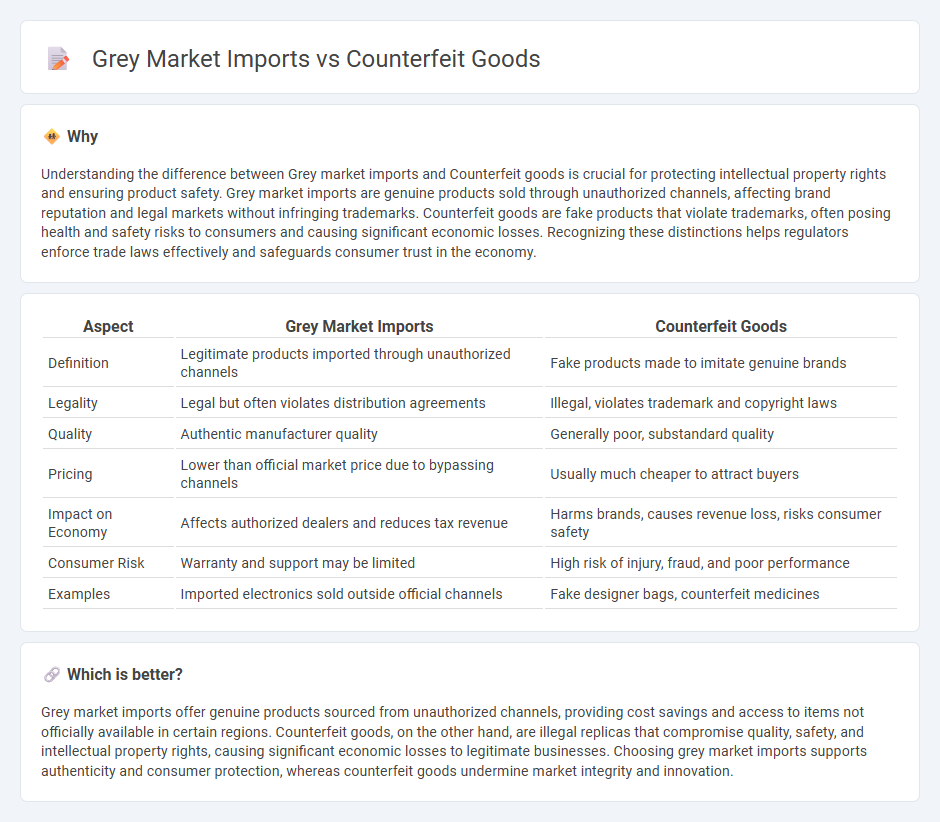
Grey market imports refer to genuine products imported and sold through unauthorized channels, often offering lower prices but lacking official warranties. Counterfeit goods, however, are fake replicas designed to deceive consumers, posing risks to safety and brand integrity. Explore our detailed analysis to understand the economic impact and consumer implications of these markets.
Why it is important
Understanding the difference between Grey market imports and Counterfeit goods is crucial for protecting intellectual property rights and ensuring product safety. Grey market imports are genuine products sold through unauthorized channels, affecting brand reputation and legal markets without infringing trademarks. Counterfeit goods are fake products that violate trademarks, often posing health and safety risks to consumers and causing significant economic losses. Recognizing these distinctions helps regulators enforce trade laws effectively and safeguards consumer trust in the economy.
Comparison Table
| Aspect | Grey Market Imports | Counterfeit Goods |
|---|---|---|
| Definition | Legitimate products imported through unauthorized channels | Fake products made to imitate genuine brands |
| Legality | Legal but often violates distribution agreements | Illegal, violates trademark and copyright laws |
| Quality | Authentic manufacturer quality | Generally poor, substandard quality |
| Pricing | Lower than official market price due to bypassing channels | Usually much cheaper to attract buyers |
| Impact on Economy | Affects authorized dealers and reduces tax revenue | Harms brands, causes revenue loss, risks consumer safety |
| Consumer Risk | Warranty and support may be limited | High risk of injury, fraud, and poor performance |
| Examples | Imported electronics sold outside official channels | Fake designer bags, counterfeit medicines |
Which is better?
Grey market imports offer genuine products sourced from unauthorized channels, providing cost savings and access to items not officially available in certain regions. Counterfeit goods, on the other hand, are illegal replicas that compromise quality, safety, and intellectual property rights, causing significant economic losses to legitimate businesses. Choosing grey market imports supports authenticity and consumer protection, whereas counterfeit goods undermine market integrity and innovation.
Connection
Grey market imports and counterfeit goods both disrupt official economic channels by bypassing authorized distribution networks, leading to significant revenue losses for legitimate businesses and governments. These imports often include counterfeit products that infringe on intellectual property rights, undermining brand integrity and consumer trust. The presence of grey market and counterfeit goods distorts market competition, hampers tax collection, and encourages illegal trade practices that negatively impact overall economic growth.
Key Terms
Intellectual Property Rights
Counterfeit goods blatantly infringe Intellectual Property Rights (IPR) by illegally replicating branded products, causing significant financial harm to original manufacturers and eroding consumer trust. Grey market imports, while genuine products, circumvent authorized distribution channels, potentially violating trademark rights and contractual agreements without directly breaching patent or copyright laws. Explore detailed insights on the legal distinctions and enforcement strategies surrounding counterfeit goods and grey market imports to safeguard intellectual property.
Parallel Importation
Counterfeit goods are unauthorized replicas that violate intellectual property rights, whereas grey market imports, or parallel imports, involve genuine products sold through unofficial channels without the brand owner's consent. Parallel importation allows consumers access to authentic products at potentially lower prices but can complicate warranty claims and after-sales service. Explore more about the legal implications and market dynamics of parallel importation.
Trademark Infringement
Counterfeit goods involve unauthorized replication of trademarked products, directly violating intellectual property rights and misleading consumers with fake branding, whereas grey market imports are genuine products sold through unauthorized channels without trademark owner consent, often raising issues of warranty and quality assurance rather than direct trademark infringement. Trademark infringement in counterfeit goods leads to significant legal actions due to consumer deception and brand dilution, while grey market goods primarily challenge distribution rights and consumer protection regulations. Learn more about the implications of trademark infringement in counterfeit versus grey market scenarios to safeguard brand integrity and consumer trust.
Source and External Links
Counterfeit consumer good - Counterfeit consumer goods are products illegally made or sold without the brand owner's authorization, often violating trademarks and typically of lower quality, posing health and safety risks while deceiving consumers into believing they are genuine.
Counterfeit goods: a bargain or a costly mistake? - The production and sale of counterfeit goods is a global, multi-billion dollar problem involving organized crime, spanning industries from luxury fashion to pharmaceuticals, and often resulting in serious economic, health, and safety consequences for consumers.
Counterfeiting (Intended for a non-legal audience) - Counterfeiting is illegal in most countries, with products often manufactured in regions with low-cost production and sold through both physical and online channels, frequently deceiving buyers who discover the fraud only after purchase.
 dowidth.com
dowidth.com